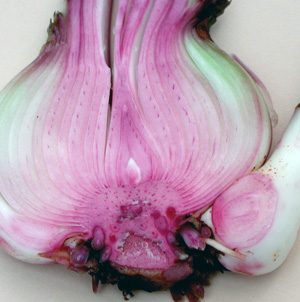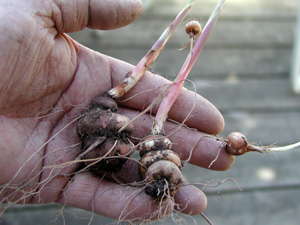Resource Library
Plant of the Week: Geophytes
The University of Arkansas System Division of Agriculture does not promote, support or recommend plants featured in "Plant of the Week." Please consult your local Extension office for plants suitable for your region.
Plant of the Week
Geophytes

Geophytes are some of my favorite plants; in fact they were favorites long before I ever heard the technical name for the group. The term geophytes simply means "earth plant," a term coined about 100 years ago to describe those plants that shelter their resting bud in the soil when environmental conditions are not to their liking.
The vernacular synonym for geophyte is "bulb" in its broadest sense, but this is too limiting to describe these magnificent garden plants. Geophytes may protect their resting bulb in any number of underground structures including bulbs, corms, rhizomes, tuberous roots, swollen tap roots and the ubiquitous crown.
Darwin was right when he described what has become known as survival of the fittest. Plants have adapted many different ways to ensure their survival during adverse growing conditions and it is no wonder that ducking below ground has been used by so many different kinds of plants. The sheltering earth provides protection from drought, heat, cold, fire and grazing animals.
In gardening the term "bulb" is generally used to describe true bulbs, corms and tuberous roots; storage organs with unique and quite different anatomies. True bulbs such as the common onion or daffodil have their resting bud buried deep inside protecting layers of leaf bases. The stem of the plant is compressed into what is called the basal plate which, like any stem, can branch and form new bulbs called offsets. Bulbs are found in many members of the lily and amaryllis family and include most of the common spring bulbs such as tulips, daffodils and hyacinths.

Corms, especially common amongst members of the iris family such as crocus and crocosmia, consist of a short swollen stem arranged vertically in the soil with buds on the outside of the starchy stem. Rhizomes are swollen stems that grow horizontally at or below the soil surface. Common rhizomatous ornamentals include iris, Solomon seal, Epimedium and some trilliums.
Tuberous roots - such as found on daylilies, dahlia and sweet potatoes - are enlarged lateral roots that swell and provide a structure for storage. True tubers, such as potatoes and caladium, are formed from enlarged underground stems called stolons. Swollen roots may be at the surface as in dandelion, carrot or turnips or subterranean as found in most trilliums, terrestrial orchids or ginseng.
The geophytic habit of growth is most common between 20 and 50 degrees north and south latitudes, the regions of the earth most prone to periods of cold, dry weather. In areas with Mediterranean climates where crocus and daffodils originated the winters and springs are moist but the summers -- when plants disappear below ground -- are hot and dry. The fall blooming crocus and other fall blooming bulbs such as surprise lilies were selected from Mediterranean region or Asia respectively, from areas with harsh, dry summers but with autumnal rains.
Common spring ephemeral wildflowers in Arkansas such as trout lilies, a true bulb, and blood root, a fleshy rhizome, grow quickly in the late winter, flower, produce seed and die down for the year before the greedy forest canopy matures and makes their life impossible.
Growing geophytes is mostly pretty easy and gardens would not be the same without them. The better your garden aligns with the seasonal characteristics of the site where the plant originated the more likely it will become established in your garden. Daffodils and crocus are considered dependable additions to any garden because they come from areas of southern Europe and the Mediterranean region that, though dry in the summer, are not strangers to summer rains. Tulips, on the other hand, originate in Central Asia at high elevations where temperatures are cool and summer rains mostly unknown, making them less likely to survive our hot and often wet summers.
By: Gerald Klingaman, retired
Retired Extension Horticulturist - Ornamentals
Extension News - April 1, 2011
The University of Arkansas System Division of Agriculture does not maintain lists of retail outlets where these plants can be purchased. Please check your local nursery or other retail outlets to ask about the availability of these plants for your growing area.